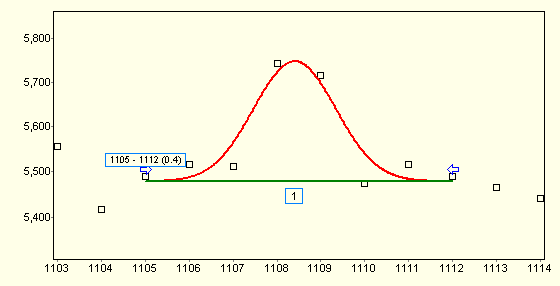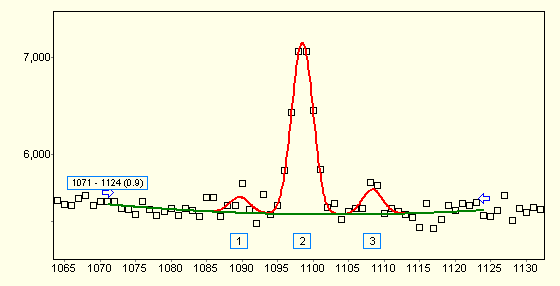Comparison with conventional Peak Area calculation method
In most cases, other gamma spectrometry applications calculates the uncertainty of the peak are based on the following model:
The model assumes a singlet peak, where a linear background region lies beside the peak, both on the left and the right sides, with
| σs
| uncertainty in peak area
|
|
| G
| gross counts under the peak (background + peak counts)
|
|
| N
| number of channels under the peak
|
|
| n
| number of channels both on the left and right sides
|
|
| B1, B2
| background counts on the left and right side
|
This approach is more or less valid, however if too narrow background region is used, the uncertainty estimations will be unnecessarily high, as this is the case of most evaluation software.
HyperLab is superior to this simple method due to the followings:
intelligently extends the region as far as possible, thus minimizing the uncertainty
its uniform calculation expression may be applied to every region, even for multiplets (in spite of different expressions used for singlet and multiplet cases, as can be seen in other applications)
may take into consideration a complex (curved and/or stepped) background
takes into consideration of the reliability of the fit (due to the partial derivatives of the fitted parameters at the minimum).
Although HyperLab applies a very different (but otherwise standard) method for peak uncertainty calculations, the calculated values agree very well with other applications, if comparable fitting situations regarded.
A typical fit of a small peak can be seen on the figure below, which contains a singlet-peak fit.
|
The reference uncertainty equation and HyperLab’s uncertainty calculation method approximately serves the same 44% area uncertainty value.
This shows that the two formulas results in nearly identical results under the same conditions.
|
|
|
|
Please note that HyperLab could reproduce this fit only after manual interventions (manually narrowing the region boundaries), as it originally determined much wider background region during the automatic fit.
|
|
|
In comparison, HyperLab's automatic fit results in 27% area uncertainty for peak No. 3 (the same peak as in the previous example). This lower value can be explained by the followings:
a much wider the background region utilized,
thus the nonlinear fitter founds a minimum with greater confidence,
therefore the uncertainty of the fitted parameters will be smaller,
so the uncertainty value of the peak area will also be significantly lower.



